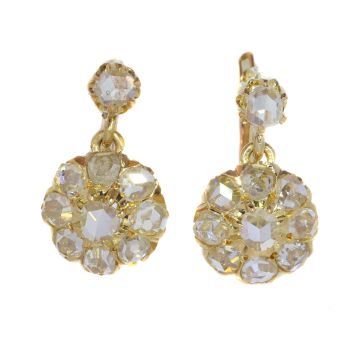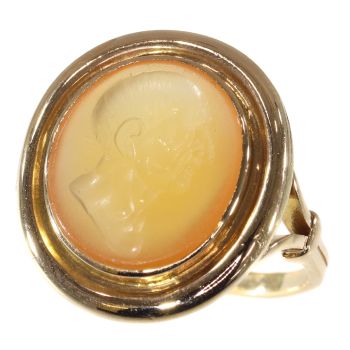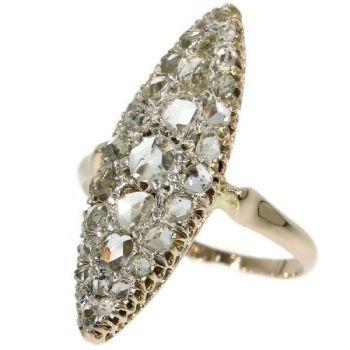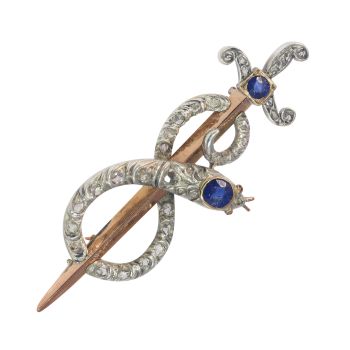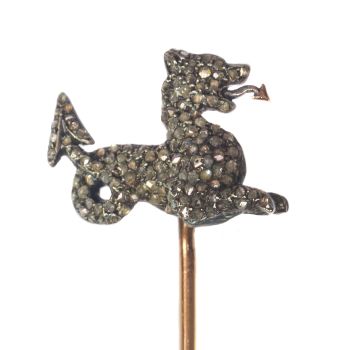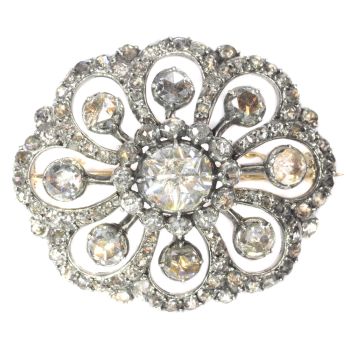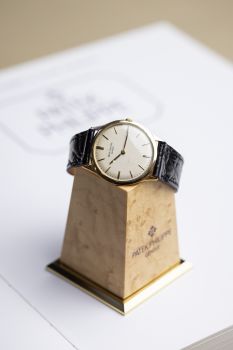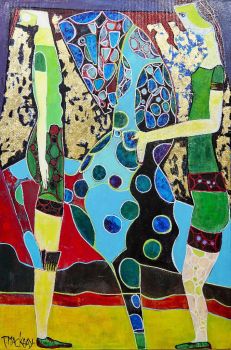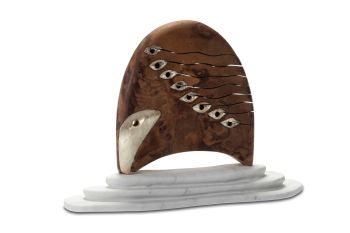Antiek zilveren Romeinse munt gemonteerd in antieke Victoriaanse broche 1870
Onbekende Kunstenaar
Goud
€ 2.750
Adin Fine Antique Jewellery
- Over kunstwerk
This brooch is a typical example of coin jewelry as made by Lucien Falize in circa 1890 (for examples see English translation of Vever on page 954 and further). The 18K gold mounting holds an ancient coin. As other jewelsby Falize it reveals an impeccable taste, despite the deliberate use of Classical sources and the beautiful works of the Renaissance in particular, which Falize knew and cherished above all others.
The coin itself has been recognized as an original ancient coin from 54 B.C.!
Antique jewelry object group: brooch
Condition: excellent condition
- (more info on our condition scale)
Country of origin:Although it does not carry any legible control marks we believe this to be of French origin.
Style: Victorian - Victorian decorative arts refers to the style of decorative arts during the Victorian era. The Victorian era is known for its eclectic revival and interpretation of historic styles and the introduction of cross-cultural influences from themiddle east and Asia in furniture, fittings, and Interior decoration. Victorian design is widely viewed as having indulged in a regrettable excess of ornament. The Arts and Crafts movement, the aesthetic movement, Anglo-Japanese style, and Art Nouveaustyle have their beginnings in the late Victorian era.
- See also: Victorianor more info on styles
Style specifics: The Grand Victorian Period - Experts divide the reign of Queen Victoria, also called The Victorian era (1837 - 1901) into three periods of about twenty years each; The Romantic Victorian Period (1837 - 1860), The Grand Victorian Period (1860 - 1880),and the Late or Aesthetic Victorian Period (1880 - 1901).
We consider this to be of the Grand Victorian Period.
This second Victorian period is famous for its ostentatious pieces set with pearls and diamonds (from South Africa). From ca. 1850 wealthy English had reported about jewelry from India and Japan, which heavily inspired the jewelers of this period. Thisperiod also corresponds with the death of Queen Victoria's husband King Albert making mourning jewelry (set with heavy dark stones) the type of jewelry specific for this period.
Period: ca. 1870
- (events and facts in 1870)
Description of coin: The coin represents the laurelled head of Santé (Salvtis). The back of the pendant showsSanté leaning on a pillar and holding in the right hand a snake (Nv. Acilivs III Vir. Valetv.).
Remarks on the coin master: The coin, a new monetary unit, with Manius as first name, proofs that he doesn't carryout his duty before approx. 700 (54 B.C.). In this era many historians were called Manius. One of them was Manius Acilius Glabrio. He was the son of a very important person, he battled under the command of Julius Cesar during the Civil war, hebecame many times governor.
Material: 18k yellow gold and silver.
- (more info on precious metals)
Hallmarks: No trace.
- (more info on hallmarks)
Dimensions: 4.70 cm (1.85 inch) by 2.70 cm (1.06 inch)
Weight: 12.00 gram (7.72 dwt)
Reference Nº: 01198-2660
Copyright photography: Adin, fine antique jewelry
- Over kunstenaar
Het kan voorkomen dat een kunstenaar of maker onbekend is.
Voor sommige werken is het niet te bepalen door wie het gemaakt is of dat het is gemaakt door (een groep) ambachtslieden. Voorbeelden zijn beelden uit de Oudheid, meubels, spiegels of handtekeningen die vaak niet duidelijk of leesbaar zijn. Maar ook sommige werken zijn helemaal niet gesigneerd.
Ook kunt u de volgende beschrijving vinden:
•"Toegeschreven aan …." waarschijnlijk een werk van de kunstenaar maar niet zeker of gedeeltelijk
•“Atelier van ….” of werkplaats van” een werk uitgevoerd in het atelier of atelier van de kunstenaar, eventueel onder zijn toezicht
•“Cirkel van ….” een werk uit de periode van de kunstenaar die zijn invloed laat zien, nauw verbonden met de kunstenaar maar niet noodzakelijkerwijs zijn leerling
•“Stijl van ….” of “Volger van ….” een werk uitgevoerd in de stijl van de kunstenaar, maar niet noodzakelijk door een leerling; kan eigentijds of bijna eigentijds zijn
•“Wijze van ….” een werk in de stijl van de kunstenaar maar van latere datum
•"Na …." een kopie (van welke datum dan ook) van een werk van de kunstenaar
•“Getekend…”, “Gedateerd….” of “Ingeschreven” dan is het werk gesigneerd/ gedateerd/ ingeschreven door de kunstenaar. De toevoeging van een vraagteken duidt op een element van twijfel
•"Met handtekening ...", "Met datum ...", "Met opschrift..." of “Draagt signatuur/datum/opschrift” dan is de handtekening/datum/opschrift toegevoegd door iemand anders dan de kunstenaar
Bent u geïnteresseerd om dit kunstwerk te kopen?
Artwork details
Related artworks
- 1 - 4 / 12
Onbekende Kunstenaar
Enchanting 1870s Vintage Fly Brooch: Victorian Elegance in Gold1870
€ 4.600Adin Fine Antique Jewellery
 Gecureerd door
Gecureerd doorDanny Bree
1 - 4 / 24- 1 - 4 / 24
Jean-François Rauzier
Chapelle Royale - Limited edition of 8 2010
Prijs op aanvraagVilla del Arte Galleries
Onbekende Kunstenaar
18e-eeuwse diamanten armband met 2000 jaar oude Romeinse intaglio's1790
€ 23.000Adin Fine Antique Jewellery
 Gecureerd door
Gecureerd doorDanny Bree
1 - 4 / 20- 1 - 4 / 24
- 1 - 4 / 12















